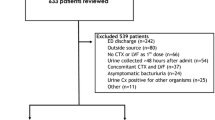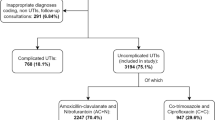Abstract
Nitrofurantoin remains a key oral antibiotic stewardship program (ASP) option in the treatment of acute uncomplicated cystitis (AUC) due to multi-drug resistant (MDR) Gram negative bacilli (GNB). However, there have been concerns regarding decreased nitrofurantoin efficacy with renal insufficiency. In our experience over the past three decades, nitrofurantoin has been safe and effective in treating AUC in hospitalized adults with renal insufficiency. Accordingly, we retrospectively reviewed our recent experience treating AUC in hospitalized adults with decreased renal function (CrCl < 60 ml/min) with nitrofurantoin. Excluded were complicated urinary tract infections. Urinary isolated susceptibility testing was done by micro broth dilution (MBD). Treatment duration was 5–7 days. Cure was defined as eradication of the uropathogen and failure was defined as minimal/no decrease in urine colony counts. Of 26 evaluable patients with renal insufficiency (CrCl < 60 ml/min), nitrofurantoin eradicated the uropathogen in 18/26 (69%) of patients, and failed in 8/26 (31%). Of the eight failures, five were due to intrinsically resistant uropathogens, e.g., Proteus sp., and one failure was related to an alkaline urine. Of the treatment failures, only two were due to renal insufficiency, i.e., CrCl < 30 ml/min. Since there are few oral antibiotics available to treat AUC due to MDR GNB uropathogens, these results have important ASP implications. Currently, nitfurantoin is not recommended if CrCl < 60 ml/min. In our experience, used appropriately against susceptible uropathogens, nitrofurantoin was highly effective in nearly all patients with CrCl = 30–60 ml/min., and only failed in two patients due to renal insufficiency (CrCl < 30 ml/ml).
Similar content being viewed by others
References
Fournier D, Chirouze C, Leroy J, Cholley P, Talon D, Plesiat P, Bertrand X (2013) Alernatives to carbapenems in ESBL-producing Escherichia coli infections. Med Mal Infect 43:62–66
Rogers BA, Sidjabat HE, Silvey A, Anderson TL, Perera S, Li J, Paterson DL (2013) Treatment options for New Delhi metallo-beta-lactamase-harboring enterobacteriaceae. Microb Drug Resist 19:100–103
Bonkat G, Muller G, Braissant O, Frei R, Tschudin-Suter S, Rieken M, Wyler S, Gasser TC, Bachmann A, Widmer AF (2013) Increasing prevalence of ciprofloxacin resistance in extended-spectrum-ß-lactamase-producing Escherichia coli urinary isolates. World J Urol 31:1427–1432
Sorlozano A, Jimenez-Pacheco A, de Dios Luna Del Castillo J, Sampedro A, Martinez-Brocal A, Miranda-Casas C, Navarro-Mari JM, Gutierrez-Fernandez J (2014) Evolution of the resistance to antibiotics of bacteria involved in urinary tract infection: a 7 year surveillance study. Am J Infect Control 42:1033–1038
Wang QY, Li RH, Shang XH (2015) Urinary tract infections caused by Enterococcus isolates: aetiology and antimicrobial resistance patterns. J Chemother 27:117–119
Auer S, Wojna A, Hell M (2010) Oral treatment options for ambulatory patients with urinary tract infections caused by extended-spectrum-beta-lactamase-producing Escherichia coli. Antimicrob Agents Chemother 54:4006–4008
Cunha CB, Varughese CA, Mylonaskis E (2013) Antimicrobial stewardship programs (ASPs): the devil is in the details. Virulence 4:147–149
Cunha BA (1988) Nitrofurantoin. Urol 32:67–71
Sanchez GV, Am B, Karlowsky JA, Master RN, Bordon JM (2014) Nitrofurantoin retains antimicrobial activity against multidrug-resistant urinary Escherichia coli from US outpatients. J Antimicrob Chemother 69:3259–3262
Cunha BA (2011) Multidrug-resistant Gram-negative bacilli causing urinary tract infections: clinical considerations. J Chemother 23:171–174
Cunha BA, Schoch P, Hage JE (2012) Oral therapy of catheter associated bacteriuria (CAB) in the era of antibiotic resistance: nitrofurantoin revisited. J Chemother 24:12–124
Grayson ML, Whitby M (2010) Nitrofurans: Nitrofurazone, Furazolidone and Nitrofurantoin. In: Grayson ML (ed) Kucers’ the use of antibiotics, 6th edn. Arnold Hodder, London, pp 1195–1205
Jackson EA, McLeod DC (1974) Pharmacokinetics and dosing of antimicrobial agents in renal impairment. Am J Hosp Pharm 31:137–148
Farag A, Garg AX, Li L, Jain AK (2014) Dosing errors in prescribed antibiotics for older persons with CKD: a retrospective time series analysis. Am J Kidney Dis 63:422–428
Gilbert DN (2006) Urinary tract infections in patients with chronic renal insufficiency. Clin J Am Soc Nephrol 1:327–331
Woodruff MW, Malvin RL, Thompson IM (1961) The renal transport of nitrofurantoin. JAMA 175:1132–1135
Cunha BA, Comer JB (1979) Pharmacokinetic considerations in the treatment of urinary tract infections. Conn Med 43:347–353
Komp Lindgren P, Klockars O, Malmberg C, Cars O (2015) Pharmacodynamics studies of nitrofurantoin against common uropathogens. J Antimicrob Chemother 70:1076–1082
Yang L, Wang K, Li H, Denstedt JD, Cadieux PA (2014) The influence of urinary pH on antibiotic efficacy against bacterial uropathogens. Urology 84(731):e1–7
Cunha BA (ed) (2015) Antibiotics essentials, 14th edn. Jay Pee Medical Publishers, New Delhi, pp 103–105
Kunin CM (2004) Inappropriate medication use in older adults: does nitrofurantoin belong on the list for the reason stated? Arch Intern Med 164:1701
Oplinger M, Andrews CO (2013) Nitrofurantoin contraindication in patients with a creatinine clearance below 60 ml/min: looking for the evidence. Ann Pharmacother 47:106–111
Geerts AF, Eppenga WL, Heerdink R, Derijks HJ, Wensing MJ, Egberts TC, De Smet PA (2013) Ineffectiveness and adverse events of nitrofurantoin in woman with urinary and renal impairment in primary care. Eur J Clin Pharmacol 69:1701–1707
Kashanian J, Hakimian P, Blute M Jr et al (2008) Nitrofurantoin: the return of an old friend in the wake of growing resistance. BJU Int 102:1634–1637
Cunha BA, Lee P, Kaouris N, Raza M (2015) The safety of nitrofurantoin for the treatment of nosocomial catheter-associated bacteriuria (CAB) and cystitis. J Chemother 27:122–123, 2015
Cunha BA (2016) An infectious disease and pharmacokinetic perspective on oral antibiotic treatment of uncomplicated urinary tract infections due to multidrug-resistant Gram-negative uropathogens: the importance of urinary antibiotic concentrations and urinary pH. Eur J Clin Microbiol Infect Dis 35:521–526
Stamey TA, Govan DE, Palmer JM (1965) The localization and treatment of urinary tract infection: The role of bactericidal urine levels as opposed to serum levels. Medicine 44:1–36
Stamey TA, Fair WR, Timothy MM et al (1974) Serum versus urinary antimicrobial concentration in cure of urinary tract infections. NEJM 291:1159–1163
Musher DM, Minuth JN, Thorsteinsson SB et al (1975) Effectiveness of achievable urinary concentrations of tetracycline against “tetracycline resistant” pathogenic bacteria. J Infect Dis 131:S40–S44
Burian A, Erdogan Z, Jandrisits C et al (2012) Impact of pH on activity of trimethoprim, fosfomycin, amikacin, colistin and ertapenem in human urine. Pharmacology 90:281–287
Author information
Authors and Affiliations
Corresponding author
Ethics declarations
Funding
No funding was received.
Conflict of interest
No conflict of interest.
Ethical approval
No ethical approval necessary with publication.
Rights and permissions
About this article
Cite this article
Cunha, B.A., Cunha, C.B., Lam, B. et al. Nitrofurantoin safety and effectiveness in treating acute uncomplicated cystitis (AUC) in hospitalized adults with renal insufficiency: antibiotic stewardship implications. Eur J Clin Microbiol Infect Dis 36, 1213–1216 (2017). https://doi.org/10.1007/s10096-017-2911-1
Received:
Accepted:
Published:
Issue Date:
DOI: https://doi.org/10.1007/s10096-017-2911-1




